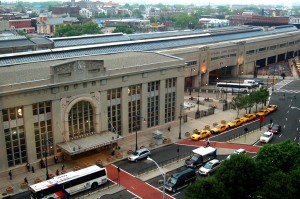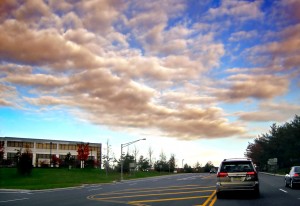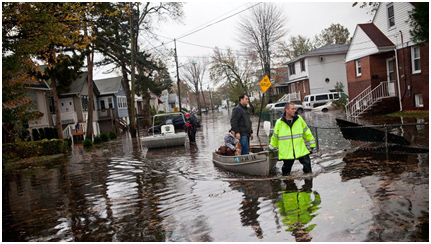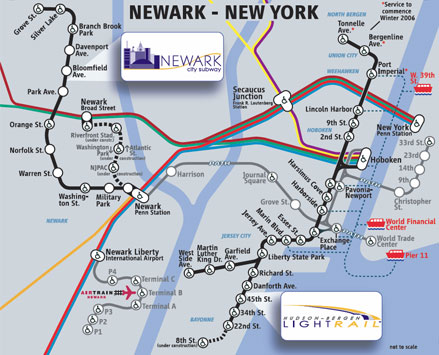New Jersey Future Blog
We Work Close to Home … But We Drive There
September 22nd, 2011 by Tim Evans
- More than half (52.9 percent) of employed New Jersey residents who do not work at home work in the same county in which they live, according to the 2005-2009 American Community Survey.
- Only 13.2 percent of New Jersey commuters work out of state. Even in Hudson County, just across the river from Manhattan, more than 70 percent of employed residents work within New Jersey, with 44 percent working within Hudson County.
- Most employed New Jerseyans (83.8 percent) drive to work, including 74.4 percent who drive alone, while 10.8 percent of commuters use public transportation — 6.3 percent commute by bus, 4.2 percent by rail and the remainder by ferry.
Commuters Choose Transit — When They Can
The recently released five-year American Community Survey (2005-2009) gives us the first look in 10 years at commuting data at the county and local level. The good news is that New Jersey is still a national leader in transit ridership; it is one of only two states (the other being New York) that exceeds a 10-percent rate of transit commuting, and some individual counties far exceed the state rate. Nearly 40 percent of employed Hudson County residents take transit to work, as do 20 percent of Essex County commuters.
The ACS data suggest room for improvement, however. In 10 of the state’s 21 counties, the transit commuting rate does not even reach the national average of 5 percent, let alone the statewide rate. The orientation of New Jersey’s transit system toward New York (and to a lesser extent Philadelphia) may enable significant numbers of New Jerseyans to commute by transit, but the system leaves most in-state workers with driving as their only option. This is especially true in light of the fact that jobs within New Jersey have been decentralizing away from transit. (See Getting to Work: Reconnecting Jobs With Transit.)
Hudson and Essex counties warrant a closer look, as examples of what can happen when New Jersey thinks about improving access to its own homegrown centers. While both counties sport higher-than-average rates of out-of-state commuting, many of them New York-bound transit commuters, both also boast good intra-county transit service, which becomes visible in their commuting statistics. While 29 percent of employed Hudson County residents work out of state, 39 percent ride transit to work; clearly, a substantial number of these workers use transit to commute to jobs within New Jersey. A similar logic applies in Essex County, where 20.5 percent ride transit to work but only 13 percent work out of state. Much of this intra-New Jersey transit commuting has undoubtedly been facilitated by the opening of the Hudson-Bergen Light Rail line and the expansion of Newark’s light-rail system.
Hudson and Essex counties remain the exceptions that prove the rule. Elsewhere in the state, the most easily accessible (and, for practical purposes, often the only) transportation option for intra-New Jersey commuting remains the highway system. But Hudson and Essex demonstrate that if new services are instituted that improve access to major employment concentrations, such as downtown Newark and the Hudson County “Gold Coast,” people will use them. To this end, the state should be trying to identify other existing employment hubs — say, Trenton or New Brunswick — where small, targeted additions to the transit network, in the form of feeder or circumferential lines, could greatly improve connectivity and accessibility and hence pay big dividends in terms of ridership.
More important, state programs and incentives should be reoriented to steer jobs to locations that already have good transit access, thus squeezing more utility out of the existing transit system without the need for new infrastructure. (The Urban Transit Hub Tax Credit is a step in this direction but should be expanded.) Putting more jobs within walking distance of transit would allow more New Jersey commuters to leave their cars at home, generating less traffic and improving air quality. If New Jersey is sitting on one of the best and most extensive transit networks in the country, it ought to put that system to work for its own benefit, instead of settling for an in-state transit commute rate that is no better than the national average.
This issue of Future Facts was based on data analysis conducted by Gabriela Wyatt. If you have any questions, please contact Research Director Tim Evans (timevans njfuture
njfuture org) .
org) .



















Perhaps more would commute if the transit system wasn’t a 3rd world operation.
Unfortunately the suburbanite culture infiltrates the mentality of planners at NJT who are soley concerned with the one roundtrip to the job and back. They don’t see a comprehensive fulltime transit system that is reliable flexible other activities as well. Creating and promoting a fare system that makes makes transfers between modes (bus, train, PATH, lightrail) conveinent, practical, and affordable. Why is are the Hackensack/Paterson bus terminals not located near train stations? Why does it take two hours, three buses, and cost $6 bucks to get from Jersey City to Cliffside Park?
We definitely agree with you about making it easier to transfer among modes, or among different operating systems (NJT, PATH, PATCO) — see our recent post about an EZ-Pass -type system for transit: http://www.njfuture.org/2011/08/12/ezpass-transit/
As one who worked in healthcare, public transit is not set for the growth of 24/7 industries. It is still heavily based on M-F 8-4/9-5 home-work.